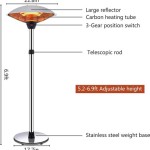How To Install a Patio Screen Door Latch
Installing a new patio screen door latch is a common home maintenance task that can significantly improve the functionality and security of your outdoor living space. A properly functioning latch ensures the screen door stays securely closed, keeping insects out and providing an additional layer of safety. This article provides a comprehensive guide on how to install a patio screen door latch, covering necessary tools, preparation steps, and a detailed walkthrough of the installation process.
Before beginning any installation project, it's crucial to gather the appropriate tools and materials. Having everything readily available will streamline the process and minimize potential delays. A typical patio screen door latch installation requires the following:
- New patio screen door latch kit (ensure it's compatible with your door type)
- Screwdriver (Phillips head and potentially flathead, depending on the screws)
- Drill (with drill bits matching the size of the screws, if pilot holes are needed)
- Measuring tape or ruler
- Pencil or marker
- Safety glasses
- Work gloves
- Optional: Utility knife (for trimming any excess material)
Once you have assembled the required tools and materials, the next step involves preparing the door and frame for the new latch. This process might involve removing the old latch, cleaning the area, and ensuring proper alignment.
Removing the Old Latch (If Applicable)
If you are replacing an existing latch, the first step is to remove the old one. This usually involves unscrewing the screws holding the latch components in place. Using the appropriate screwdriver, carefully remove the screws from both the handle side and the strike plate (the part that attaches to the door frame). If the screws are stripped or difficult to remove, try using a screw extractor tool or applying a small amount of penetrating oil. Once the screws are removed, gently detach the latch components from the door and frame.
Cleaning and Assessing the Area
After removing the old latch, thoroughly clean the area on both the door and the frame where the new latch will be installed. Use a clean cloth or brush to remove any dirt, debris, or old adhesive residue. Inspect the area for any damage or irregularities. If there are any cracks, splinters, or uneven surfaces, address these issues before proceeding with the installation. You may need to use wood filler or sandpaper to create a smooth and even surface for the new latch to sit flush against.
Ensuring Proper Alignment
Before installing the new latch, it's essential to ensure proper alignment between the door and the frame. Close the screen door and check the gap between the door and the frame. The gap should be consistent along the entire length of the door. If the door is sagging or misaligned, you may need to adjust the door hinges or rollers to achieve proper alignment. Proper alignment is crucial for the latch to function correctly and securely.
With the preparation phase complete, you can now proceed to install the new patio screen door latch. This process typically involves installing the handle side of the latch on the door and the strike plate on the frame, ensuring that they align properly.
Installing the Handle Side of the Latch
Begin by positioning the handle side of the latch on the door, aligning it with the existing holes (if applicable) or according to the manufacturer's instructions. Use a pencil or marker to mark the screw locations on the door. If the instructions recommend creating pilot holes, use a drill with a drill bit matching the size of the screws to drill shallow pilot holes. This will make it easier to drive the screws in and prevent the wood from splitting. Carefully align the handle side of the latch with the marked screw locations and use a screwdriver to securely fasten it to the door. Avoid over-tightening the screws, as this can damage the latch or the door.
Installing the Strike Plate
Next, install the strike plate on the door frame. Close the screen door and check where the latch bolt from the handle side aligns with the frame. Use a pencil or marker to mark the location for the strike plate. Ensure that the strike plate is positioned so that the latch bolt can easily engage with it. As with the handle side, if the instructions recommend creating pilot holes, drill shallow pilot holes at the marked screw locations. Align the strike plate with the marked screw locations and use a screwdriver to securely fasten it to the frame. Again, avoid over-tightening the screws.
Testing the Latch
After installing both the handle side and the strike plate, thoroughly test the latch to ensure it functions correctly. Open and close the screen door several times, checking that the latch bolt engages smoothly with the strike plate and that the door stays securely closed. If the latch is not engaging properly, you may need to adjust the position of the strike plate slightly. Loosen the screws on the strike plate, reposition it slightly, and re-tighten the screws. Repeat this process until the latch engages smoothly and securely.
Once the primary installation is complete, several additional steps can further refine the functionality and appearance of the patio screen door latch.
Adjusting the Latch for Smooth Operation
If the latch feels stiff or requires excessive force to operate, you may need to adjust the mechanism. Some latches have adjustable components, such as tension screws or levers, that can be tweaked to improve the smoothness of the operation. Refer to the manufacturer's instructions for specific guidance on adjusting the latch. Lubricating the moving parts of the latch with a small amount of silicone-based lubricant can also help to improve its smoothness.
Ensuring a Secure Fit
Examine the fit between the latch components and the door and frame. Ensure there are no gaps or loose connections. If there are any gaps, you may need to use shims or spacers to create a tighter fit. A secure fit is essential for the latch to function effectively and provide adequate security.
Addressing Cosmetic Issues
After the latch is installed and functioning correctly, address any cosmetic issues, such as exposed screw heads or rough edges. You can use screw covers or caps to conceal the screw heads and create a cleaner appearance. If there are any rough edges or sharp corners, you can use a utility knife or sandpaper to smooth them out. A well-installed and aesthetically pleasing latch can enhance the overall appearance of your patio screen door.
Preventive maintenance is crucial for ensuring the long-term performance and reliability of your patio screen door latch. Regular cleaning, lubrication, and inspection can help to prevent problems and extend the lifespan of the latch.
Regular Cleaning
Periodically clean the latch components with a damp cloth to remove any dirt, dust, or debris that may accumulate. Avoid using harsh chemicals or abrasive cleaners, as these can damage the finish or the internal mechanisms of the latch. A mild soap and water solution is usually sufficient for cleaning purposes.
Lubrication
Lubricate the moving parts of the latch with a small amount of silicone-based lubricant at least once a year. This will help to keep the latch operating smoothly and prevent corrosion. Avoid using oil-based lubricants, as these can attract dirt and grime.
Inspection
Regularly inspect the latch components for any signs of wear, damage, or loose connections. Check the screws to ensure they are tight and the strike plate is securely fastened. If you notice any problems, address them promptly to prevent further damage. Replacing worn or damaged components can help to maintain the functionality and security of the latch.
Key Points to Remember
Choosing the Right Latch
Selecting the appropriate latch is paramount. Consider the door's thickness, the material of the frame, and the existing hardware. Purchasing a latch incompatible with these factors can lead to installation difficulties and functional issues. Measure the door carefully and consult product specifications before making a purchase.
Proper Alignment is Crucial
Alignment between the latch mechanism and the strike plate directly impacts the latch's efficiency. Misalignment can result in difficulty closing the door, a loose fit, or even a complete failure of the latch. Pay close attention to the positioning of both components during installation and adjust as needed to ensure a secure and smooth closure.
Don't Overtighten Screws
It's tempting to overtighten screws to ensure a secure fit, but this can damage the door or frame. Overtightening can strip the screw holes, crack the surrounding wood, or even break the latch itself. Use a moderate amount of force when tightening screws and stop when they are snug.
By following these steps and guidelines, homeowners can successfully install a patio screen door latch, enhancing the functionality, security, and overall appeal of their outdoor living spaces. Regular maintenance and attention to detail will ensure the latch provides years of reliable service.

How To Replace Sliding Door Lock Handle Easy Simple Latch

Home Security Safety Tips How To Adjust A Sliding Screen Door Lock

How To Replace A Sliding Glass Door Latch Patio Replacement Won T Lock

How To Install The 05 004 Sliding Screen Door Latch Pull

How To Replace Sliding Patio Door Lock Remove And Install

Marvin Sliding Screen Door Latch And Pull Handle Set Black Finish

How To Install A Screen Door

How To Replace A Screen Door Latch Handle Lock

How To Install A Screen Door

How To Install A Screen Door








